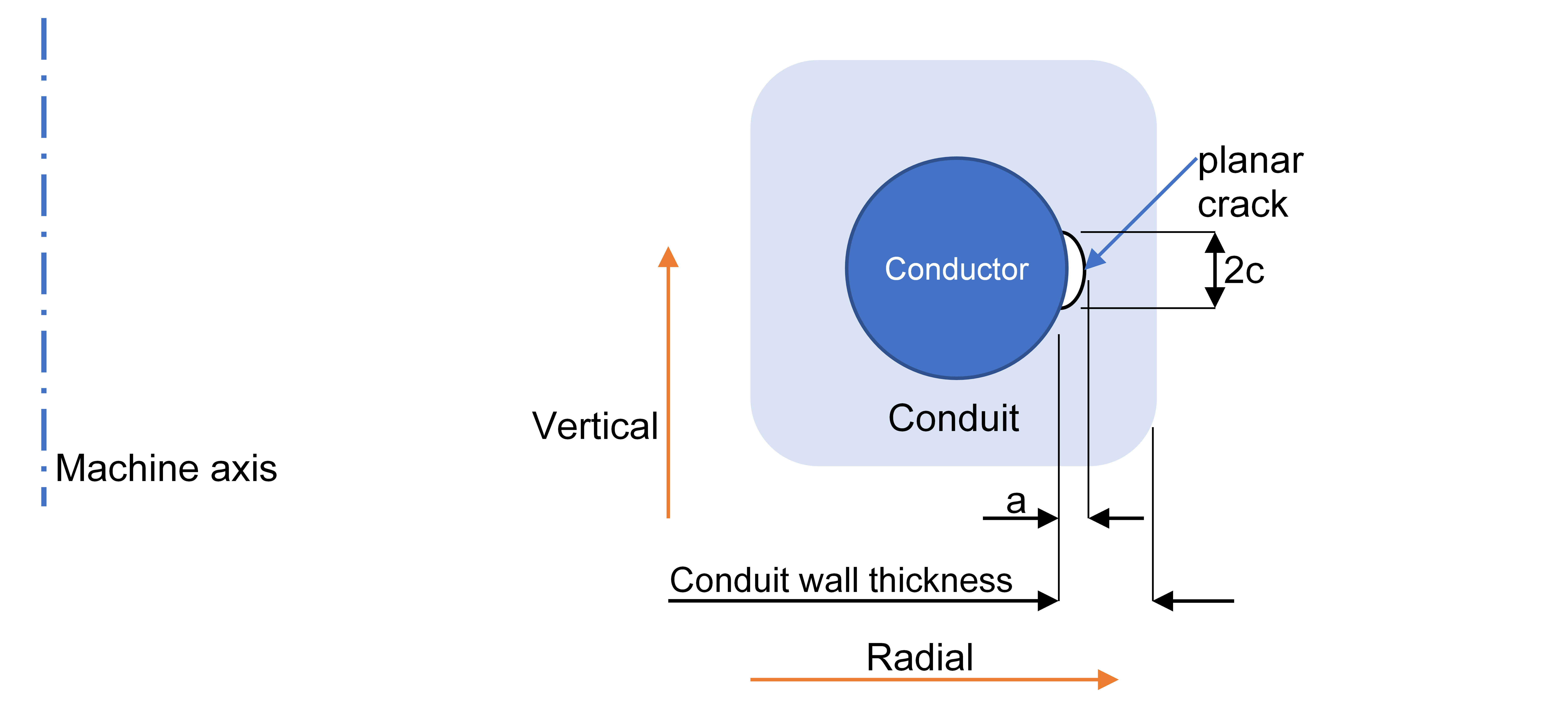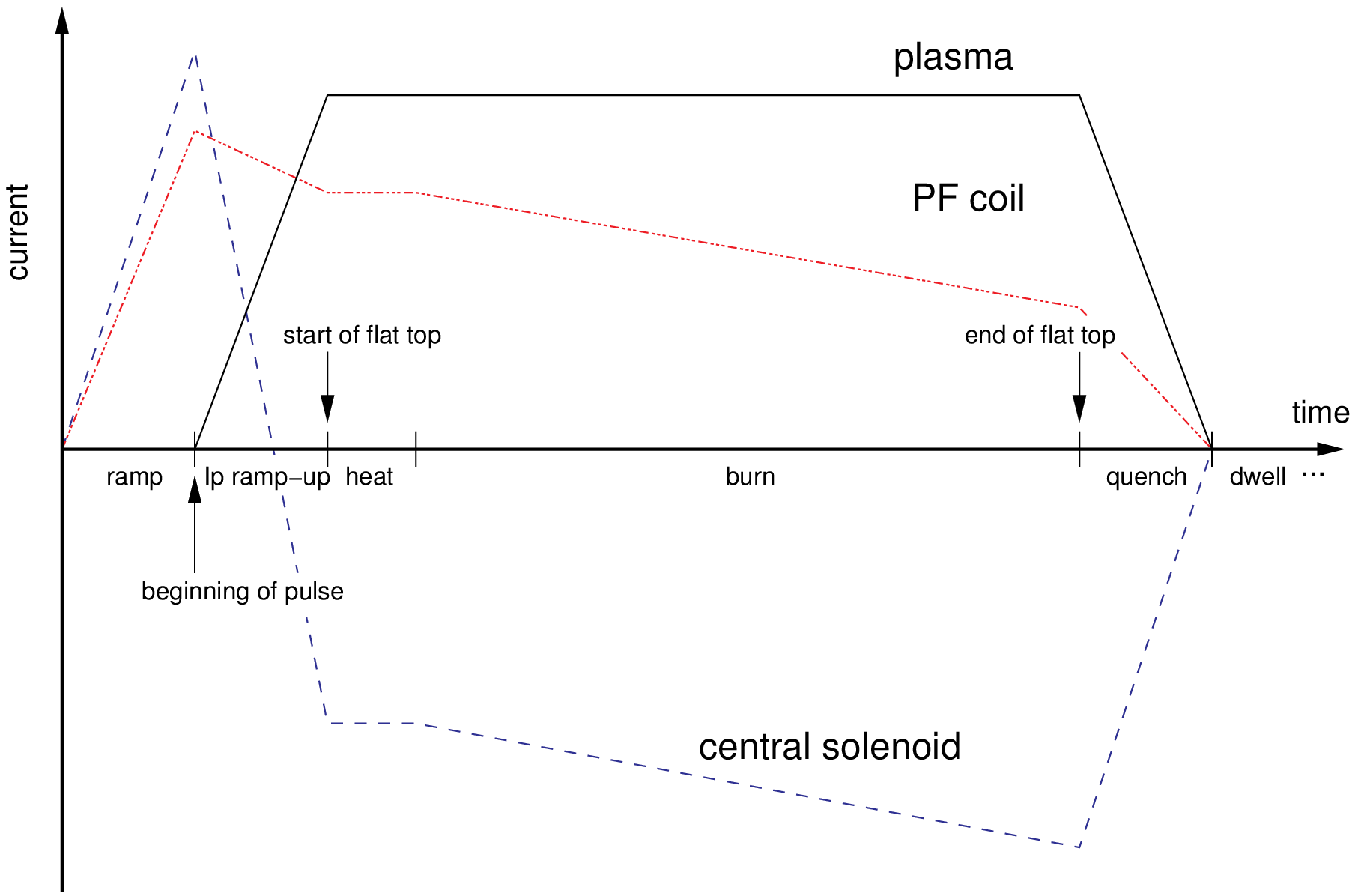Central Solenoid
The central solenoid (CS) is a PF coil used during start-up and during the burn phase to create and
maintain the plasma current by electromagnetic induction. Swinging (changing) the current through
the central solenoid causes a change in the flux linked to the plasma region, inducing a current in
it. PROCESS calculates the amount of flux required to produce the plasma curren, and also the
amount actually available. The code measures the magnetic flux in units of Volt.seconds (= Webers).
Switch iohcl controls whether a central solenoid is present. A value of 1 denotes that this coil
is present, and should be assigned a non-zero thickness ohcth. A value of iohcl = 0 denotes
that no central solenoid is present, in which case the thickness ohcth should be zero. No PF
coils should be located at positions defined by ipfloc(j) = 1 if no central solenoid is present.
The central solenoid can be either resistive or superconducting (controlled via switch ipfres as
for the other PF coils), and if superconducting, switch isumatpf determines the superconducting
material to use - its value is used like isumattf and isumatpf. The copper fraction (by volume)
of the superconducting strands is fcuohsu.
The hoop stress is calculated using equations 4.10 and 4.11 from "Superconducting magnets", Martin N. Wilson (1983). This is divided by the fraction of the area occupied by steel to obtain the hoop stress in the steel, \sigma_{hoop}.
The axial stress can be calculated using "Case studies in superconducting magnets", Y. Iwasa, p. 86, 3.5.2, Special Case 4: Midplane force. This applies exactly only to a thin-walled solenoid. The axial stress in the steel is given by:
where F_z is the axial force, f_z is the fraction of the horizontal cross-section occupied by steel, and A_z is the area of the horizontal cross-section.
The fraction of the horizontal cross-section occupied by steel is calculated assuming that the conductor is square and has a steel jacket with the same thickness on all four sides, giving:
The radial stress is neglected. The hoop and axial stresses are combined to give the maximum shear stress, as required by the Tresca stress criterion:
However, the axial stress is only included if the switch i_cs_stress = 1. The axial stress is
set to zero if i_cs_stress = 0. This option has no physical justification but can be used if
there are reasons to be believe that the calculation above gives unrealistically large stresses.
Fatigue
If the the reactor is assumed to be pulsed, the CS must be assessed against fatigue.
A simple crack growth model based on Linear Elastic Fracture Mechanics is used to estimate the allowable hoop stress in the conduits. The model follows the method described in the ITER Magnet Structural Design Criteria, using the Paris law to model the growth of a planar elliptical crack across the thickness of a plate with the width and thickness of the conduit wall. The Paris law states that the crack growth rate follows a power law:
where a is the size of the crack, N is the number of cycles, C and m are material constants, and \Delta K is the stress intensity factor. The stress intensity factor is, in turn, a function of the crack geometry, the residual stress in the conduit, and the alternating tensile stress (i.e. hoop stress in the case of the CS coils).
Assumptions
- The initial defect is a planar half-elliptical surface crack, normal to the long axis of the conductor.
- Initial aspect ratio of ellipse (semi-major radius (c) /semi-minor radius (a) = 3).
- Initial crack dimensions are input. Defaults: a0=2, c0=6 mm.
- The coupled Paris equations for the crack dimensions are integrated using the "Life Cycle" method, in which the crack dimension (either a or c) is the variable of integration.
- Only the hoop stress is taken into account.
- The stress is monotonic (since the hoop stress is always positive), and its minimum value is the residual stress (input). Default: 240 MPa.
- The mean stress is taken into account using the Walker modification of the Paris equation, with coefficient \gamma=0.436
- Failure occurs when the crack dimension a equals the conduit thickness, or dimension c reaches the conductor width.
- No safety factor is used for the number of cycles.
- A safety factor of 2 is used for the crack size.
An example output follows. Note that in this example the cycle life is not sufficient.
Residual hoop stress in CS Steel (Pa) (residual_sig_hoop) 2.400E+08
Minimum burn time (s) (tbrnmn) 7.200E+03
Initial vertical crack size (m) (t_crack_vertical) 8.900E-04
Initial radial crack size (m) (t_crack_radial) 2.670E-03
CS turn area (m) (a_oh_turn) 1.904E-03
CS turn length (m) (l_cond_cst) 7.557E-02
CS turn internal cable space radius (m) (r_in_cst) 6.732E-03
CS turn width (m) (d_cond_cst) 2.519E-02
CS structural vertical thickness (m) (t_structural_vertical) 5.863E-03
CS structural radial thickness (m) (t_structural_radial) 5.863E-03
Allowable number of cycles till CS fracture (n_cycle) 7.529E+02 OP
Minimum number of cycles required till CS fracture (n_cycle_min) 2.000E+04 OP
The parameters for the Paris law are hard-coded as follows, based on the properties of stainless steel 316LN from Sarasola et al, IEEE Transactions on Applied Superconductivity, vol. 30, no. 4, pp. 1-5, (2020):
C = 65e-14 m m = 3.5
The model has some limitations:
- Cycle life is just an output. There is no constraint to ensure the cycle life is sufficient.
- The model only includes hoop stress.
The required cycle life is set in different ways depending on the following switch.
If bkt_life_csf = 1 then n_cycle_min = bktcycles, which is calculated using the blanket life model.
If bkt_life_csf = 1 then n_cycle_min is an input.
Pre-compression structure
The central solenoid model in PROCESS consists of a single coil. In practice, however, a central
solenoid usually consists of several coils, which can have opposite currents. This leads to vertical
forces that tend to separate the coils. To prevent this, ITER has "tie-plates" which hold the coil
segments together. PROCESS has a corresponding structure, known as the pre-compression structure,
made up of two cylinders, one on the inside and one on the outside, of the same thickness. The
radii of the two cylinders are bore and bore + ohcth. The thickness is derived using the
separation force and the combined cross-sectional area:
where:
p = precomp CS coil precompression structure thickness (m)
F = fseppc Separation force
f = fcspc Fraction of space occupied by pre-compression structure
\sigma = sigallpc allowable stress in pre-compression structure (Pa)
The central solenoid pre-compression structure is included in the model if and only if iprecomp = 1.
Current density inputs and limits
The absolute value of the central solenoid current density at the end-of-flat-top ('EOF'), coheof,
is specified by the user, and can be used as an iteration variable (no. 37). The current density at
the beginning-of-pulse ('BOP' - See Figure 1) is specified as a (positive) fraction of coheof
using fcohbop (iteration variable no. 41). The current density in the CS at all other times is
calculated by taking into account the flux swing necessary to initiate and maintain plasma current.
The current density in the central solenoid can be limited at BOP and at EOF. To limit the current
density at BOP, constraint equation no. 27 is used with iteration variable no. 39 (fjohc0). To
limit the current density at the EOF, constraint equation no. 26 should be turned on with iteration
variable no. 38 (fjohc).
The critical current density Jcrit is a function of the temperature of the superconductor.
The temperature margin \DeltaT is the difference between the current sharing temperature and the
operating temperature. The current sharing temperature is the temperature at which Jcrit
is equal to the operating current density Jop. The minimum allowed \DeltaT can be
set using input parameter tmargmin together with constraint equation no. 60 and iteration variable
no. 106 (ftmargoh).
It is recommended that EITHER the temperature margin constraint (60), OR the current density constraints (26 and 27) are activated.

